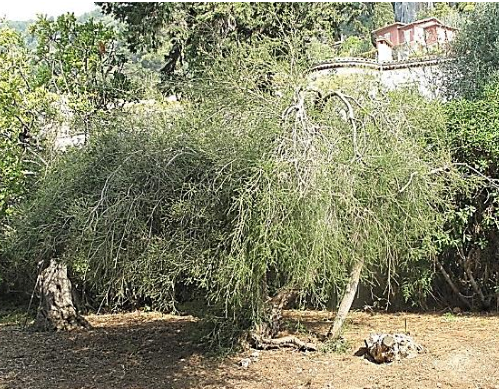澳洲茶樹(Tea tree,Melaleuca alternifolia)
桃金孃科(Myrtaceae)白千層屬(Melaleuca)
學名:Melaleuca alternifolia
別名:TTO

圖:Melaleuca alternifolia[1]
憑藉顯著且多樣的藥效,茶樹精油成為澳洲士兵在第二次世界大戰時的重要物資。雖然曾因抗生素的發展使需求一度衰退,但在1970s時又因天然物熱潮而讓茶樹精油產業再次復甦[2]。在澳洲、英國、義大利和巴西等地,也常以凝膠、藥皂和乳液等劑型外用,尤其是在多種皮膚感染疾病的治療上[3-4]。
【生理活性】
茶樹精油大略可分成6種化學型,包含萜品烯-4-醇(terpinen-4-ol)、萜品烯(terpinolene)以及4種桉葉油醇(1,8-cineole)型。市面上販售的產品主要是萜品烯-4-醇化學型,含30-40%的萜品烯-4-醇。生鮮葉片的萃油率約在1-2%[2、5]。
ISO 4730是萜品烯-4-醇型茶樹精油的成分組成規範[6],其個別成分的規範濃度皆有一定道理[2],例如:納入香檜烯(sabinene)、藍桉醇(globulol)和綠花白千層醇(viridiflorol)等微量分子至成分清單中,是為了增加仿造天然精油的成本和困難度;萜品烯-4-醇是發揮抑菌功效的主要成分,因此規範濃度下限30%,無上限;雖然限制桉葉油醇濃度僅容許15%的理由是它的皮膚、黏膜高刺激性[5],不過這理由可能是由於不嚴謹推論,加上多次引用建議,因而渲染形成的訛傳。後期新的研究認為桉葉油醇並非刺激物[7],反而可降低刺激感[8],也稍緩解桉葉油醇的尷尬處境。
雖然因高刺激性而限制桉葉油醇濃度是否站得住腳仍有待商榷,但桉葉油醇的低濃度依舊有其必要性,因萜品烯-4-醇和桉葉油醇的濃度常是負相關[9],也就是說,濃度偏高的桉葉油醇可能導致萜品烯-4-醇低於30%規範濃度,使抑菌效果下降[10-13]。
久放的茶樹精油可能會改變成分,異丙基甲苯(p-cymene)濃度上升,α-萜品烯(α-terpinene)和γ-萜品烯(γ-terpinene)含量衰退[9],茶樹精油應儲存在低氧容器內,放置在陰暗乾燥環境。
民俗療法
澳洲邦加隆(Bundjalung)原住民藉茶樹精油處理瘀傷、昆蟲咬傷和皮膚感染[14]。1949年英國藥典描述茶樹精油可殺菌,局部治療癤病(furunculosis)、皮癬、甲溝炎、膿皰症、口腔炎[5]。
抗發炎
澳洲茶樹精油在水中的溶解度約1.6 g/L,分析成分組成84% 萜品烯-4-醇、7% α-萜品醇(α-terpineol)和3%桉葉油醇。人外周血單核細胞(human peripheral blood monocytes)實驗顯示[15],精油水溶物(等同精油濃度0.125%)能有效抑制細胞發炎反應中發炎因子的釋放,其中TNF-α、IL-1β和IL-10可抑制57-58%,PGE2可抑制32%,後續實驗證實抑制能力來自萜品烯-4-醇的功效。
抗過敏
在小鼠接觸過敏原30分鐘前或7小時後塗擦茶樹精油可有效抑制過敏反應導致的腫脹,不過對暴露於UVB引起的腫脹無效[16]。另一研究在組織胺和compound 48/80誘導小鼠過敏後,立即塗擦10μL未稀釋茶樹精油,可顯著壓制腫脹反應進行[17]。成分內的萜品烯-4-醇是茶樹精油能抗過敏的主要原因[18]。
27名自願者注射組織胺5μg於前臂,20分鐘後塗抹25μL純茶樹精油或礦物油,結果10分鐘內茶樹精油可顯著減少腫塊大小,但無法抑制過敏造成的發紅[19]。鎳金屬誘發的接觸型過敏臨床研究描述[20],100%純茶樹精油能顯著降低發紅面積或皮膚紅斑,5%茶樹精油乳液和100%澳洲堅果油皆沒有明顯效果。
傷口癒合
含0.25%茶樹精油的乳膏塗擦在小鼠皮膚傷口持續10天,能有效增進傷口癒合,相較於控制組第8天癒合69.2%,茶樹精油組已癒合80.6% [21]。配方劑型的適切性關乎功效的發揮,含1%茶樹精油的奈米膠囊和奈米乳液凝膠能顯著減少小鼠因UVB照光誘導耳朵的腫脹大小,奈米乳液凝膠減少大鼠傷口癒合的速度也表現較好,優於奈米膠囊凝膠和一般凝膠[22]。
可能風險
茶樹精油的使用有近百年歷史,長期使用史代表它是相對安全且低副作用的精油。大鼠的50%致死劑量在1.9-2.6 ml/kg [23]。孩童[24-25]和成人[26-27]都曾有口服茶樹精油中毒的案例,在給予支持性治療恢復後,並未觀察到明顯後遺症。
217位受測者參與的貼膚試驗,10%茶樹精油未發現刺激性反應[28]。曾造成皮膚過敏,不過並非原有成分導致,而是久放或保存瑕疵形成的氧化物所引起[29-31]。
【芳療功效】
5%茶樹精油和5%過氧化苯(benzoyl peroxide)治療青春痘的臨床試驗表示[32],兩者皆能減少發炎,整體過氧化苯表現較優。過氧化苯在減少油脂分泌的效果較好,但茶樹精油舒緩療程間皮膚起屑、搔癢和乾燥的表現略勝一籌,發生副作用的人也僅約使用過氧化苯的一半。
持續7天使用0.2%茶樹精油漱口水可有效降低口腔中轉糖鏈球菌(Streptococcus mutans)和總生菌數,且停止使用後還可維持2周有效[33]。2.5%茶樹精油雖能減少牙齦發炎指數(gingival index)和齒間乳突出血指數(papillary bleeding index),卻可能增加牙菌斑[34],代表總生菌數和菌斑生成的相互關係不見得相關。茶樹精油漱口水也可降低口中異味分子,使口腔清新[35]。
236位帶有抗藥性金黃色葡萄球菌(MRSA)病患參與的隨機雙盲臨床研究[36]。一組使用標準療程,包括2% 莫匹羅星(mupirocin)鼻用軟膏每天3次、4% 葡萄糖酸氯己定(chlorhexidine gluconate)藥皂每天至少清潔1次、1%磺胺嘧啶銀(silver sulfadiazine)乳膏塗擦於皮膚傷口或潰瘍每天1次;另一組則以相同給藥頻率改使用10%茶樹精油鼻用軟膏、5%茶樹精油沐浴乳和10%茶樹精油乳膏,兩組療程同為5天。結果標準療程有49%殺死MRSA,茶樹精油有41%,兩組無顯著差異,茶樹精油效果可比擬標準療程。
茶樹精油也被利用在多種真菌性感染的治療或輔助/合併治療,例如:灰指甲(onychomycosis) [37-38]、香港腳(tinea pedis)[39-40]、頭皮屑(dandruff)[41]、鵝口瘡(oral candidiasis)[42-43]和陰道念珠菌感染(vaginal candidiasis)[44]。
參考資料:
(1)Rajantereh, Y. (2015). Extraction of Essential Oils from Melaleuca alternifolia sp.(Australian Tea Tree Plant) using Solvent Extraction Method. IRC.
(2)Carson, C. F., Hammer, K. A., & Riley, T. V. (2006). Melaleuca alternifolia (tea tree) oil: a review of antimicrobial and other medicinal properties. Clinical microbiology reviews, 19(1), 50-62.
(3)Oliveira, T. R., Teixeira, A. L., Barbosa, J. P., de Feiria, S. N. B., Boni, G. C., Maia, F., ... & Höfling, J. F. (2020). Melaleuca spp. essential oil and its medical applicability. A Brief Review. Brazilian Journal of Natural Sciences, 3(1), 249-249.
(4)de Andrade Santiago, J., das Graças Cardoso, M., Batista, L. R., Santiago, W. D., Passamani, F. R. F., Rodrigues, L. M. A., & Nelson, D. L. (2018). Effect of the essential oils from Melaleuca alternifolia, Melaleuca quinquenervia and Backhousia citriodora on the synthesis of ochratoxin A by Aspergillus niger and Aspergillus carbonarius isolated from tropical wine grapes. Journal of food science and technology, 55(1), 418-423.
(5)EMA, H. (2014). Assessment report on Melaleuca alternifolia (Maiden and Betch) Cheel, M. linariifolia Smith, M. dissitiflora F. Mueller and/or other species of Melaleuca, aetheroleum, 1-71.
(6)https://www.iso.org/standard/69082.html
(7)Southwell, I. A., Freeman, S., & Rubel, D. (1997). Skin irritancy of tea tree oil. Journal of Essential Oil Research, 9(1), 47-52.
(8)Takaishi, M., Fujita, F., Uchida, K., Yamamoto, S., Sawada, M., Hatai, C., ... & Tominaga, M. (2012). 1, 8-cineole, a TRPM8 agonist, is a novel natural antagonist of human TRPA1. Molecular pain, 8, 1744-8069.
(9)Brophy, J. J., Davies, N. W., Southwell, I. A., Stiff, I. A., & Williams, L. R. (1989). Gas chromatographic quality control for oil of Melaleuca terpinen-4-ol type (Australian tea tree). Journal of Agricultural and Food Chemistry, 37(5), 1330-1335.
(10)Carson, C. F., & Riley, T. V. (1995). Antimicrobial activity of the major components of the essential oil of Melaleuca alternifolia. Journal of applied bacteriology, 78(3), 264-269.
(11)Cox, S. D., Mann, C. M., & Markham, J. L. (2001). Interactions between components of the essential oil of Melaleuca alternifolia. Journal of Applied Microbiology, 91(3), 492-497.
(12)Hammer, K. 1., Carson, C. F., & Riley, T. V. (2003). Antifungal activity of the components of Melaleuca alternifolia (tea tree) oil. Journal of applied microbiology, 95(4), 853-860.
(13)Raman, A., Weir, U., & Bloomfield, S. F. (1995). Antimicrobial effects of tea‐tree oil and its major components on Staphylococcus aureus, Staph. epidermidis and Propionibacterium acnes. Letters in applied microbiology, 21(4), 242-245.
(14)Budhiraja, S. S., Cullum, M. E., Sioutis, S. S., Evangelista, L., & Habanova, S. T. (1999). Biological activity of Melaleuca alternifolia (tea tree) oil component, terpinen-4-ol, in human myelocytic cell line HL-60. Journal of manipulative and physiological therapeutics, 22(7), 447-453.
(15)Hart, P. H., Brand, C., Carson, C. F., Riley, T. V., Prager, R. H., & Finlay-Jones, J. J. (2000). Terpinen-4-ol, the main component of the essential oil of Melaleuca alternifolia (tea tree oil), suppresses inflammatory mediator production by activated human monocytes. Inflammation Research, 49(11), 619-626.
(16)Brand, C., Grimbaldeston, M. A., Gamble, J. R., Drew, J., Finlay-Jones, J. J., & Hart, P. H. (2002). Tea tree oil reduces the swelling associated with the efferent phase of a contact hypersensitivity response. Inflammation Research, 51(5), 236-244.
(17)Brand, C., Townley, S. L., Finlay-Jones, J. J., & Hart, P. H. (2002). Tea tree oil reduces histamine-induced oedema in murine ears. Inflammation Research, 51(6), 283-289.
(18)Khalil, Z., Pearce, A. L., Satkunanathan, N., Storer, E., Finlay-Jones, J. J., & Hart, P. H. (2004). Regulation of wheal and flare by tea tree oil: complementary human and rodent studies. Journal of investigative dermatology, 123(4), 683-690.
(19)Koh, K. J., Pearce, A. L., Marshman, G., Finlay‐Jones, J. J., & Hart, P. H. (2002). Tea tree oil reduces histamine‐induced skin inflammation. British Journal of Dermatology, 147(6), 1212-1217.
(20)Pearce, A. L., Finlay-Jones, J. J., & Hart, P. H. (2005). Reduction of nickel-induced contact hypersensitivity reactions by topical tea tree oil in humans. Inflammation Research, 54(1), 22-30.
(21)Jemon, K. In Vivo Wound Healing Activity Of Melaleuca Essential Oil-based Cream.
(22)Flores, F. C., De Lima, J. A., Da Silva, C. R., Benvegnú, D., Ferreira, J., Burger, M. E., ... & Da Silva, C. D. B. (2015). Hydrogels containing nanocapsules and nanoemulsions of tea tree oil provide antiedematogenic effect and improved skin wound healing. Journal of nanoscience and nanotechnology, 15(1), 800-809.
(23)Russell, M. I. C. H. A. E. L. (1999). Toxicology of tea tree oil. Tea tree: the genus Melaleuca, 9, 191-201.
(24)Del Beccaro, M. A. (1995). Melaleuca oil poisoning in a 17-month-old. Veterinary and human toxicology, 37(6), 557-558.
(25)Jacobs, M. R., & Hornfeldt, C. S. (1994). Melaleuca oil poisoning. Journal of Toxicology: Clinical Toxicology, 32(4), 461-464.
(26)Elliott, C. (1993). Tea tree oil poisoning. The Medical Journal of Australia, 159(11-12), 830-831.
(27)Seawright, A. (1993). Tea tree oil poisoning. Medical Journal of Australia, 159(11), 831.
(28)Veien, N. K., Rosner, K., & Skovgaard, G. L. (2004). Is tea tree oil an important contact allergen?. Contact dermatitis, 50(6), 378-379.
(29)De Groot, A. C., & Weyland, J. W. (1992). Systemic contact dermatitis from tea tree oil. Contact Dermatitis, 27(4), 279-280.
(30)Hausen, B. M., Reichling, J., & Harkenthal, M. (1999). Degradation products of monoterpenes are the sensitizing agents in tea tree oil. American Journal of Contact Dermatitis, 10(2), 68-77.
(31)Rutherford, T., Nixon, R., Tam, M., & Tate, B. (2007). Allergy to tea tree oil: retrospective review of 41 cases with positive patch tests over 4.5 years. Australasian Journal of Dermatology, 48(2), 83-87.
(32)Bassett, I. B., Barnetson, R. S. C., & Pannowitz, D. L. (1990). A comparative study of tea‐tree oil versus benzoylperoxide in the treatment of acne. Medical Journal of Australia, 153(8), 455-458.
(33)Groppo, F. C., Ramacciato, J. C., Simoes, R. P., Florio, F. M., & Sartoratto, A. (2002). Antimicrobial activity of garlic, tea tree oil, and chlorhexidine against oral microorganisms. International dental journal, 52(6), 433-437.
(34)Soukoulis, S., & Hirsch, R. (2004). The effects of a tea tree oil‐containing gel on plaque and chronic gingivitis. Australian dental journal, 49(2), 78-83.
(35)Takarada, K. (2005). P29 The effects of essential oils on periodontopathic bacteria and oral halitosis. Oral Diseases, 11, 115-115.
(36)Dryden, M. S., Dailly, S., & Crouch, M. (2004). A randomized, controlled trial of tea tree topical preparations versus a standard topical regimen for the clearance of MRSA colonization. Journal of Hospital Infection, 56(4), 283-286.
(37)Buck, D. S. (1994). Comparison of Two Topical Preparations for the Treatment of Onychornycosis: Melaleuca altemifilia (Tea Tree) Oil and Clotrimazole. The Journal of family practice, 38(6).
(38)Syed, T. A., Qureshi, Z. A., Ali, S. M., Ahmad, S., & Ahmad, S. A. (1999). Treatment of toenail onychomycosis with 2% butenafine and 5% Melaleuca alternifolia (tea tree) oil in cream. Tropical Medicine & International Health, 4(4), 284-287.
(39)Satchell, A. C., Saurajen, A., Bell, C., & Barnetson, R. S. (2002). Treatment of interdigital tinea pedis with 25% and 50% tea tree oil solution: a randomized, placebo‐controlled, blinded study. Australasian journal of dermatology, 43(3), 175-178.
(40)Tong, M. M., Altman, P. M., & Barnetson, R. S. (1992). Tea tree oil in the treatment of tinea pedis. Australasian Journal of Dermatology, 33(3), 145-149.
(41)Satchell, A. C., Saurajen, A., Bell, C., & Barnetson, R. S. (2002). Treatment of dandruff with 5% tea tree oil shampoo. Journal of the American Academy of Dermatology, 47(6), 852-855.
(42)Jandourek, A., Vaishampayan, J. K., & Vazquez, J. A. (1998). Efficacy of melaleuca oral solution for the treatment of fluconazole refractory oral candidiasis in AIDS patients. Aids, 12(9), 1033-1037.
(43)Jose A, V., & Ahmad A, Z. (2002). Efficacy of alcohol-based and alcohol-free melaleuca oral solution for the treatment of fluconazole-refractory oropharyngeal candidiasis in patients with AIDS. HIV Clinical Trials, 3(5), 379-385.
(44)Di Vito, M., Fracchiolla, G., Mattarelli, P., Modesto, M., Tamburro, A., Padula, F., ... & Carbonara, G. G. (2016). Probiotic and tea tree oil treatments improve therapy of vaginal candidiasis: a preliminary clinical study. Med J Obstet Gynecol, 4(4), 1-6.


 留言列表
留言列表


